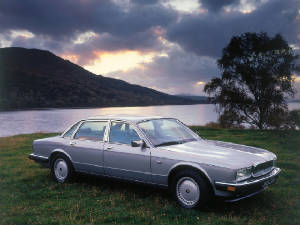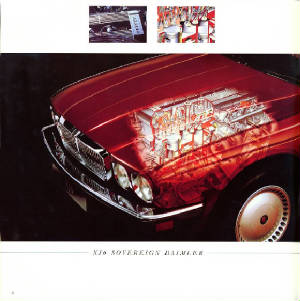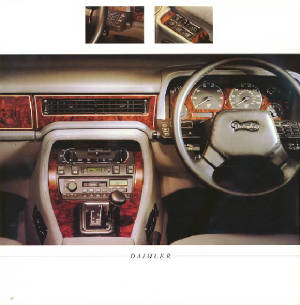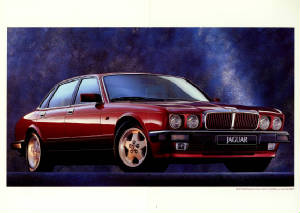 |
|
|
 |
|

|
| XJ40 on test in Arizona in 1985 |
In the 1970s Jaguar Cars Ltd began work on the "XJ40" project, a car
to replace the extremely successful XJ6 range. After a long development period of 10 years the XJ40 was unveiled to
the world in London
on the 28th of August 1986 by Sir John Egan calling the project "A landmark in automotive history." This was followed
by a large press conference in Northern Scotland in September '86. Motoring Journalists of the time dubbed the XJ40 "The best saloon
car in the world" beating regularly in group tests competitors from BMW, Mercedes-Benz, Rolls Royce and the ever popular XJ6
Series III that it was designed to replace. This was the most advanced car to ever be designed and built in Britain with microprocessors controlling many functions of the car. It also had many innovative features including the
"J" gate gear selector, vacuum fluorescent gauges on the dash board and a "VCM" computer with dot matrix read out.
Launched initially in three guises, XJ6, Sovereign and Daimler the
XJ40 was a comfortable, refined and economical sports saloon that the team at Coventry must have been proud of. The XJ6 was the "base" model but had a very large amount of equipment
as standard and at just under £17,000 for the 2.9 it represented good value undercutting the recently launched Rover Sterling
by £2,000. The XJ6 was available with 2.9 and 3.6 litre "AJ6" Engines, the latter being a DOHC 24 valve and both came
with a 5 speed manual gearbox or optional 4 speed automatic. Next up the model line was the Sovereign fitted with Leather
upholstery, Air conditioning, ABS, better quality walnut trim and extra chrome. These models are easily identified
by two square headlamps as oppose to the XJ6s four round items. Top of the range was the Daimler fitted with every option
fitted as standard like an electric sunroof, walnut picnic tables and alloy wheels to name a few. This model was only
made with a 3.6 engine mated to the four speed automatic transmission and it also had the square headlamps.
|
 |
|

|
| A 1986 Sovereign 3.6 |
The first of many minor revisions to the range came in 1988 with the
introduction of more aerodynamic door mirrors, improved stereo systems, and revised windscreen waist panel. The
Sovereign also gained the "teardrop" style metric alloy wheels from the Daimler with five hole centre caps, rear reading lights
and the deletion of the black boot infill panel. In 1989 a new sports model called the XJR was introduced with 16" alloy
wheels, momo steering wheel, bodykit and similar equipment levels to the Daimler. The XJ40 consistently outsold all
its rivals in 1989 becoming the most popular executive car of the late eighties and towards the end of this year Jaguar was
sold to Ford.
|
 |
|

|
| The new 4.0 engine fitted from 1990 |
.After the Ford take over the 1990 model year XJ40 had some major
revisions, mainly an enlarged version of the AJ6 DOHC engine giving 4 litres and 235 bhp. This engine replaced the 3.6
and was available with a manual or four speed automatic transmission with "Sport" mode and an optional Catalyst. All
models now had improved door handles with high security locks and the dashboard was substantially improved with analogue gauges
and a small digital read out at the bottom showing odometer, computer functions and fault codes. Sovereigns and
Daimlers also had chrome rimmed rear lights. Also in this year a long wheel base model called the Majestic was launched
in the U.S.
In 1991 the 2.9 engine was dropped in favour of a short stroke AJ6 DOHC engine giving 3.2 litres and 200 bhp. The
rest of the range now had 15" wheels as standard (390 metric wheels an option) with the Daimler getting a new "Roulette" style.
Better stereo systems with CD compatibility, new side repeaters and catalysts are now standard. The XJR was fitted
with a more subtle bodykit and new 16" Aerosport alloy wheels.
|
 |
|

|
| 1990 model dashboard in a Daimler |
Although there
were no major revisions in 1992 the same can't be said for 1993 as the car underwent its last major update. All models
now had an airbag, improved climate control panel, new door trims and switches, resculptured seats, and a new front valance
with integrated foglamps. The XJ6 had minor colour coding, matt black finish to grille and door pillars and new wheeltrims.
Sovereigns now had 12 hole alloy wheels and less chrome at the rear.
The Series III XJ12 was still in production until 1992 as the XJ40
had been deliberately designed not to accept a "Vee" engine as its been speculated that British Leyland that controlled
Jaguar during the 1970s had wanted to fit the Buick/Rover V8 engine to it. Jaguar engineers had not wanted this so it
was designed slightly too narrow at the front but this also meant that the legendary Jaguar V12 could not be fitted.
With design work fully under way for the X300 by 1993 it was obvious to slightly change the frontal geometry to accept the
V12 and as the X300 is based on a XJ40 bodyshell the modifications were brought in for the 1993 model year. The new
XJ12 and Daimler Double Six were now born with the V12 engine enlarged from 5.3 litres to 6.0 and mated to the 4 speed automatic
gearbox it pumped out an astonishing 318 bhp. The XJ12 had similar equipment levels to the Sovereign but was
fitted with round headlights, matt black grille veins and 16" cross-spoke alloy wheels. The Double Six was comparable
in equipment to the Daimler but was fitted with different wheels.

|
| 1993 XJ6 3.2 S |
1993 also saw
the launch of the Majestic in the UK and the 3.2 S and 4.0 S. These were of XJ6 spec with sports suspension, standard
leather sports seats, rosewood trim and 16" five spoke alloys. This car was aimed at a younger buyer than the normal
Jaguar buyer and at only £28,450 for the 3.2 it must have taken some customers from the BMW 5 Series. In 1994 Jaguar
was readying itself for the launch of the X300 model to replace the XJ40 but one last model called the XJ6 Gold was launched.
It was essentially a 3.2 XJ6 with leather upholstery, automatic transmission, burr walnut trim and 16" alloy wheels as standard.
At £28,950 this car was very cheap considering the level of specification and even featured gold plated "Jaguar" and "XJ6
Gold" badges on the boot.
So after a production run of eight years and 208,706 units the XJ40's production came to
an end in June 1994. The last car, a Solent Blue Sovereign 4 litre was given to the Jaguar Daimler Heritage Trust as
an exhibit in their museum. August 1994 saw the introduction of the X300, a car built on the floorpan and bodyshell
of the XJ40 with the outer panels pressed to resemble the curving, classic lines of the XJ6 Series III.
|
|



